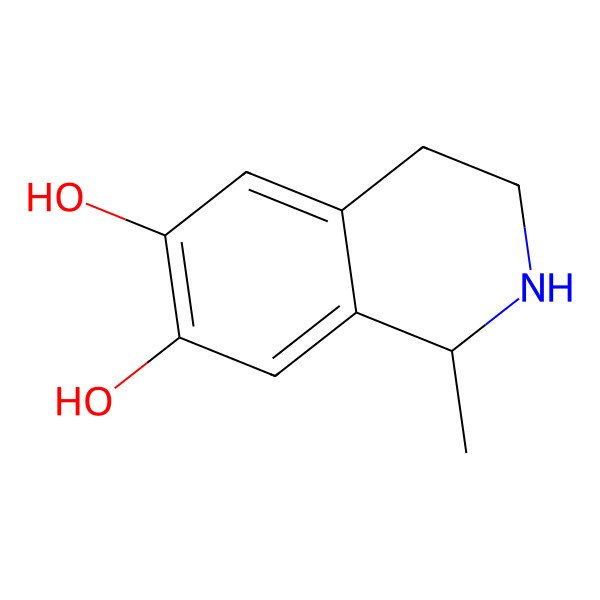Salsolinol
| Internal ID | 0a71a2a1-b992-4381-be34-3278b81abb9d |
| Taxonomy | Organoheterocyclic compounds > Tetrahydroisoquinolines |
| IUPAC Name | (1S)-1-methyl-1,2,3,4-tetrahydroisoquinoline-6,7-diol |
| SMILES (Canonical) | CC1C2=CC(=C(C=C2CCN1)O)O |
| SMILES (Isomeric) | C[C@H]1C2=CC(=C(C=C2CCN1)O)O |
| InChI | InChI=1S/C10H13NO2/c1-6-8-5-10(13)9(12)4-7(8)2-3-11-6/h4-6,11-13H,2-3H2,1H3/t6-/m0/s1 |
| InChI Key | IBRKLUSXDYATLG-LURJTMIESA-N |
| Popularity | 293 references in papers |
| Molecular Formula | C10H13NO2 |
| Molecular Weight | 179.22 g/mol |
| Exact Mass | 179.094628657 g/mol |
| Topological Polar Surface Area (TPSA) | 52.50 Ų |
| XlogP | 1.00 |
| (-)-Salsolinol |
| 27740-96-1 |
| (S)-salsolinol |
| (1s)-1-methyl-1,2,3,4-tetrahydroisoquinoline-6,7-diol |
| S-(-)-Salsolinol |
| CHEBI:113 |
| CHEMBL1195032 |
| 6,7-Isoquinolinediol, 1,2,3,4-tetrahydro-1-methyl-, (1S)- |
| 6,7-Isoquinolinediol, 1,2,3,4-tetrahydro-1-methyl-, (S)- |
| 9ILS801M65 |
| There are more than 10 synonyms. If you wish to see them all click here. |

| Target | Value | Probability (raw) | Probability (%) |
|---|---|---|---|
| No predicted properties yet! | |||
Proven Targets:
| CHEMBL ID | UniProt ID | Name | Min activity | Assay type | Source |
|---|---|---|---|---|---|
| CHEMBL3397 | P11712 | Cytochrome P450 2C9 |
15848.9 nM |
Potency |
via CMAUP
|
| CHEMBL217 | P14416 | Dopamine D2 receptor |
5000 nM |
Ki |
PMID: 24559070
|
| CHEMBL234 | P35462 | Dopamine D3 receptor |
500 nM 500 nM |
Ki Ki |
via Super-PRED
PMID: 24559070 |
| CHEMBL4159 | Q99714 | Endoplasmic reticulum-associated amyloid beta-peptide-binding protein |
251.2 nM 251.2 nM 6309.6 nM |
Potency Potency Potency |
via CMAUP
via Super-PRED via CMAUP |
| CHEMBL4261 | Q16665 | Hypoxia-inducible factor 1 alpha |
1995.3 nM 1995.3 nM |
Potency Potency |
via CMAUP
via CMAUP |
| CHEMBL1293226 | B2RXH2 | Lysine-specific demethylase 4D-like |
11220.2 nM |
Potency |
via CMAUP
|
| CHEMBL1963 | P16473 | Thyroid stimulating hormone receptor |
12589.3 nM |
Potency |
via CMAUP
|
Predicted Targets (via Super-PRED):
| CHEMBL ID | UniProt ID | Name | Probability | Model accuracy |
|---|---|---|---|---|
| CHEMBL5619 | P27695 | DNA-(apurinic or apyrimidinic site) lyase | 98.08% | 91.11% |
| CHEMBL3251 | P19838 | Nuclear factor NF-kappa-B p105 subunit | 93.32% | 96.09% |
| CHEMBL3137262 | O60341 | LSD1/CoREST complex | 88.47% | 97.09% |
| CHEMBL2581 | P07339 | Cathepsin D | 87.29% | 98.95% |
| CHEMBL241 | Q14432 | Phosphodiesterase 3A | 87.01% | 92.94% |
| CHEMBL1951 | P21397 | Monoamine oxidase A | 85.63% | 91.49% |
| CHEMBL253 | P34972 | Cannabinoid CB2 receptor | 85.44% | 97.25% |
| CHEMBL5697 | Q9GZT9 | Egl nine homolog 1 | 83.53% | 93.40% |
| CHEMBL213 | P08588 | Beta-1 adrenergic receptor | 83.40% | 95.56% |
| CHEMBL4203 | Q9HAZ1 | Dual specificity protein kinase CLK4 | 80.80% | 94.45% |
| CHEMBL1994 | P08235 | Mineralocorticoid receptor | 80.70% | 100.00% |
Below are displayed all the plants proven (via scientific papers) to contain this
compound!
To see more specific details click the taxa you are interested in.
To see more specific details click the taxa you are interested in.
| PubChem | 91588 |
| NPASS | NPC33338 |
| ChEMBL | CHEMBL1195032 |
| LOTUS | LTS0155847 |
| wikiData | Q27890466 |